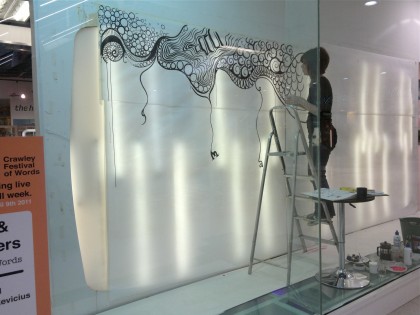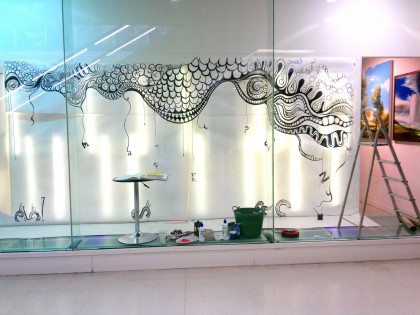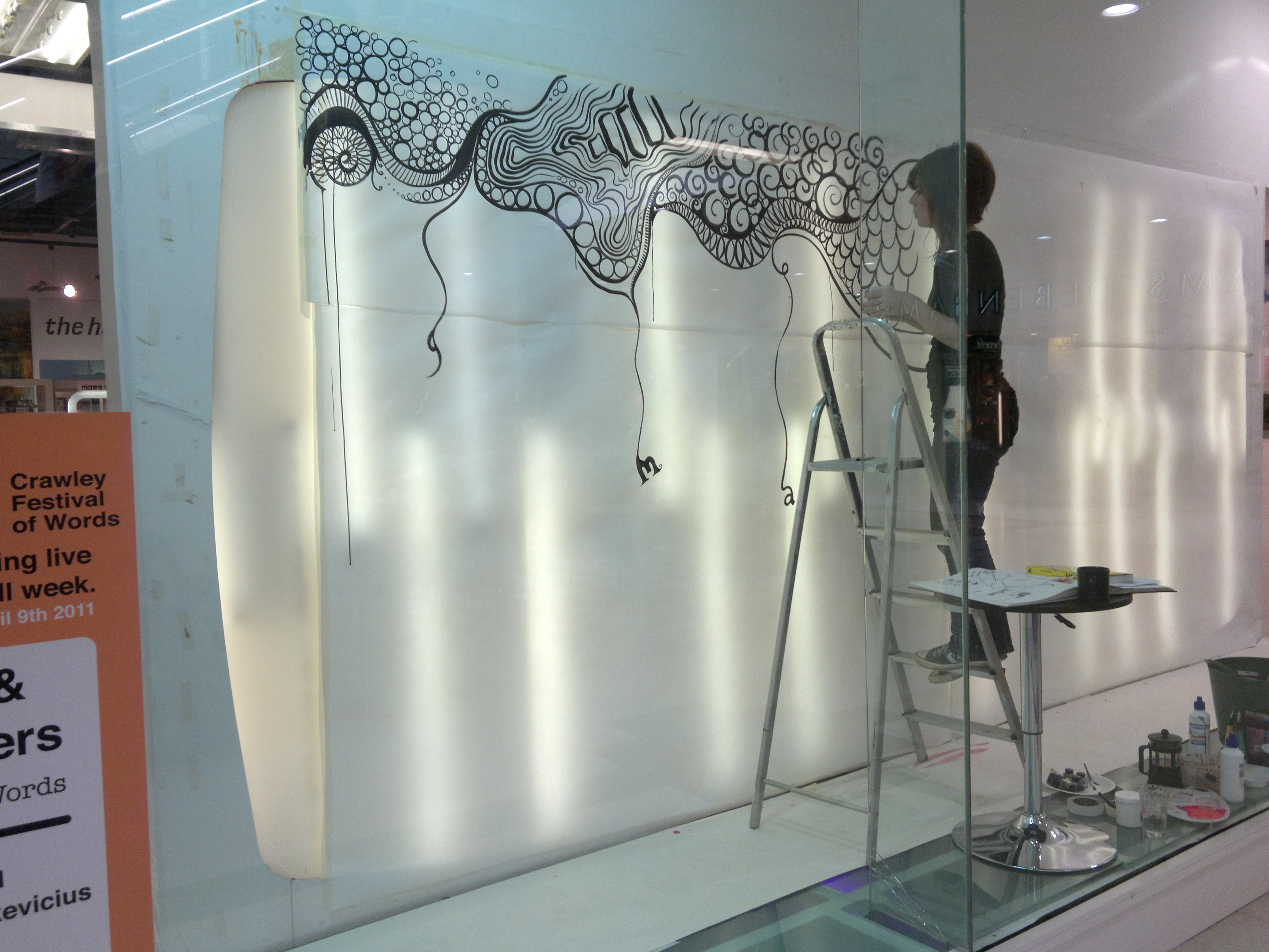Work can take us to some odd places, and put us in front of interesting sights. Recently I ended up in Crawley, and as I walked along the high street, a window display that was taking shape caught my eye. I’d been watching for several minutes before I thought to grab my mobile phone and take this picture. The window dressing artist had hung some plain white paper as a background, and was creating patterns on it in black paint with a thin brush.

There was a flow and a pace to her work. She was lost in concentration, unaware of the onlookers and clearly enjoying what she was doing. The white paper was rapidly transforming into an intriguing backdrop. Had I arrived a few days later, I probably would have walked right past and not given it a second thought. Being there during the construction gave me the opportunity to appreciate the beauty of the process, the beauty of the work, not just the outcome.
A different perspective, a different outcome.
Using different perspectives to change things obviously isn’t a new idea. Much of my study time at the moment is spent in the depths of Social Psychology. It is an academic field with all the challenges of working between two disciplines (Sociology and Psychology) and bears the scars of long fought battles about the nature and position of ‘the person’. These differences have lead to distinctly different perspectives, and different methods associated with them. The way that we see reality, and the tools that we use to access it, actually change our reality, as they shift our attitudes and our behaviours.
The same applies to work, and the way that we perceive and frame it. Management science comes from a tradition that centered on ‘piece work’ in the manufacturing world. Frederick Winslow Taylor and the other founding fathers focused on how work could be optimised – increasing flow rates and output. Inherent in that thinking were the assumptions that:
- Work is well defined and repeatable
- The exact specifications of the work are known at the outset.
- Production can be simplified.
- There is a mass market.
- People are ‘standard resources’
- All resources (people) are nominally equal and substitutable.
- There is simply ‘good’ or ‘bad’ where ‘good’ and ‘bad’ equate to fast and slow.
- Resources ‘soldier‘ – workers are lazy, not autonomous, and do not self actualise.
- Workers act as individuals, not as groups
- Individual pay is the primary motivation.
- Workers must co-ordinated, work must be individualised.
Now, I don’t know about your work and your teams, but mine aren’t like that. However, I do recognise that style of management (although not around these parts!). Just like the window dresser in the picture, knowledge-based businesses, and the workers in them, operate in a world where the exact specifications of the work are often not known at the outset. People are often passionate about their work and do not ‘soldier’ – they find flow, they push boundaries, they want to learn and discover. They also don’t work alone – even when it looks as if they do.

I am sure that if that person in the shop window had been given numbered instructions that said ‘pick up brush’, ‘dip in paint’, ‘draw circle 300mm’, ‘draw another circle of 57mm next to the circle’, ‘repeat 400 times’ the result wouldn’t have been the lovely backdrop that emerged. When I was working in Asia, and in Africa, I saw art produced that way – cheaply and at volume. Sadly, a huge amount of physical work went in to creating artefacts that had little commercial value. The majority of the products our businesses produce are not mass market, their value rests in their uniqueness. Just as significantly, the process of the work, once mechanised, was far less enjoyable, both for the artist and for the observer. That leads me on to the third assumption… That work is done as individuals in groups, rather than groups containing individuals.
Social Psychology, whichever of its perspectives you choose to follow, asserts and demonstrates that no person is an island (to un paraphrase that song). We are impacted by those that work around us. Most obviously by their work (ie their output), but also by their attitudes and demeanor. I can’t remember meeting someone who had autonomy in their role for many, many years. In a world of matrix management, virtual teams, and cross-disciplinary working, we constantly rely on the input and actions of other people to ‘get the job done’. In the knowledge-based world it is all about the group, not the individual.
Kurt Lewin and others recognised the importance and effect of the interactions between people. The friction between workers and managers is friction in the process of work itself. Even more so in knowledge-based business, where much of what happens is dependent on the discretionary effort of individuals. Those touch points are typically commitments – “you need this from me” or “I need this from you”. Work can be defined as a series of commitments, the final one representing an end goal. In the case of the window dresser, that might have been articulated as the delivery of a captivating window display, that was sympathetic to the ‘brand values’ of the shop.
However, even the most beautiful of work can be made ugly by reducing it to a list of inflexible work items to be done by anyone, with a minimum of discretionary effort and no personal interaction… Rather than minimising interactions, maximise them, and rather than over specifying the way to do something, under specify it, but set expectations about the value and purpose of the results.
Milestone Planner was built as a way for teams to work together in outcome-based, commitment lead environments. Having a place to track commitments (large ones as Milestones and smaller ones as Actions) leaves our minds free to get on with quality work (rather than fretting about who needs what by when). And having work defined in terms of outcomes enables us to use our skill and creativity to get the very best results.
Work can be beautiful. More than that it should be beautiful. It needs to be, in order to get the best from any team. Google makes the work place beautiful, by providing amazing facilities to its employees, other businesses focus on amazing problems that satisfy people’s personal need to make a difference. The challenge for every business leader is to make work more beautiful.


Nicely put, for skilled workers who are competent in their individual roles, and can work autonomously! The exception arises in instances where you need more structure in place, as in where people are still learning, or growing, and the ‘loose’ nature, of outcomes and dialogue leaves people unable to figure out a solution as quickly as if they were told it, and where the people experience the frustration of not being able to figure out what needs to be done.
The artist, when learning, would have been given much more precise instruction, and much more feedback, and direction when they first started to learn to paint/draw, and it’s easy to assume that people are capable/competent enough to be able to just figure it out. Unfortunately, and I’ve seen this numerous times, where there’s a massive skills or knowledge deficit in the individual completing the work, much more structure and instruction is needed. It’s only when that gap is filled, and competence exists, that a more ‘free flowing’, and outcomes based work style can be adopted, IMHO.